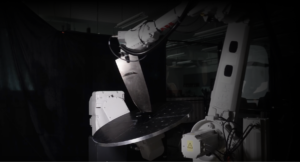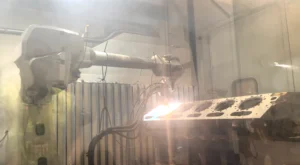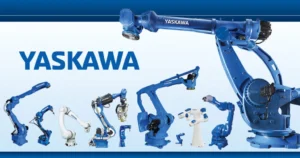table of contents
- Heading 1
- Heading 1
- Heading 1
- What Is Robotic Welding?
- Robotic Welding Process: How Does It Work?
- 5 Types of Robotic Welding Processes
- Advantages of Robotic Welding in Industrial Manufacturing
- Challenges in Robotic Welding
- Innovations in Robotic Welding: Augmentus Vision-Guided Welding
- Examples of Augmentus Robotic Welding Applications
- The Future of Robotic Welding: Trends and Predictions
- Conclusion
- FAQs
share this
The welding industry is rapidly adopting modern automation technologies to enhance its efficiency and productivity. As metallic components become an important part of industrial product ranges, advanced welding operations are being favored by most modern businesses. Automated robotic welding uses programming to help manufacturers improve the speed and accuracy of welding operations while reducing the risk of employee injury.
As the manufacturing industry makes automated welding a part of their production undertakings, we are interested in developing a better understanding of the automated robotic welding process. How does a robotic welding system work, and how can it enhance the productivity of industrial manufacturing? Are there any challenges to adopting automated robotic welding, and how can we solve them in the future?
If these questions make you curious, read on to learn about the future of automated welding technology in better detail.
What Is Robotic Welding?
Robotic welding is an advanced manufacturing process that uses robotic machines to perform automated welding tasks. It uses specially designed industrial robots to autonomously or semi-autonomously join or weld metal components. The use of industrial robot welding helps industries achieve precise results in a shorter time frame, while also guaranteeing better safety and less waste.
Industrial robots employed to perform welding operations are typically guided by a digital twin of the product through computer-aided design(CAD) models or 3D scanning. Another method is through programming instructions to execute high-precision welds. They can operate a range of welding techniques such as arc welding, spot welding, and gas metal arc welding under the supervision of human welders who control the overall welding process. Moreover, robotic welding systems can be equipped with built-in sensors and cameras that allow monitoring of the entire welding process.
Robotic Welding Process: How Does It Work?
Robotic welding systems use mechanized programmable tools to automate most parts of the welding process. Typically, the welding and handling cycles are carried out by a robot, while the only human task left is to load ingots into the furnace.
The most standard robotic welding machinery is made up of two main parts:
- A mechanical unit that performs the welding function.
- A controller or “brain” moves the mechanical arms to implement desired motions.
The movements of a robotic welding unit are either pre-programmed or controlled by machine vision technology. Here are the main steps involved in a robotic welding process:
Programming and Setup
Welding technicians and engineers collaborate to program robotic welding systems by defining welding paths, parameters, and sequences based on the requirements of a specific welding process. In traditional robotics welding, programmers use methods like jogging, lead through, etc to set up welding apparatuses. After this, the welding system is prepared with the necessary fixtures and welding tools installed in their designated positions. The fixtures hold welding workpieces which are set up and prepared to create proper weld quality. Automated robotic welding is usually done through an offline programming software.
Welding
The industrial robot welding machinery carries out industrial welding functions according to programmed instructions. This involves moving the welding tools along a predefined path to melt and fuse metal parts. Different devices may be used throughout the welding process to monitor and control various machine parameters like arc voltage, current, speed, and torch position.
Quality monitoring
Once a welding cycle is complete, the welded parts undergo inspection procedures such as visual checks, non-destructive testing, and other quality control measures to ensure consistent product quality.
Post Processing
After the competition of welding and inspection processes, finished parts undergo many post-processing treatments to give them a final touch. These treatments could include steps such as grinding, polishing, coating application, and packing of the welded parts.
5 Types of Robotic Welding Processes
Here are the five main types of robotic welding processes:
Arc Welding
Arc welding is a type of robotic welding that uses heat generated from an electrode to melt and weld metal parts together. This process is commonly utilized for welding applications that need high accuracy and repeatability.
Arc welding can be further divided into subtypes, such as:
- Gas Metal Arc Welding uses a consumable electrode wire and shielding gas to protect the welding pool from contamination.
- Gas Tungsten Arc Welding uses non-consumable tungsten electrodes and a shielding gas(often argon) to create the weld.
- Shielded Metal Arc Welding or Stick Welding, where a consumable electrode is coated with flux to create the weld.
TIG Welding
Tungsten Inert Gas welding is a form of arc welding that uses a non-consumable tungsten electrode to produce a weld. It is utilized in projects that require precision welding, such as complex machine parts or bicycle frames. This is a slow and complex welding process as it focuses on details and precision of results.
Robotic MIG Welding
Metal Inert Gas welding is a fusion welding process that uses a mixture of fuel gas to generate a high-temperature flame for melting the filler metal to create a weld. It is a versatile and portable industrial welding process that is best used for applications that require simplicity and speed. It is widely used in automotive repair, plumbing, metal fabrication, and repair work.
Resistance Welding
Resistance welding is the process of using electrodes to clamp and pass an electric current through overlapping metal sheets. This creates a pool of heat between metal parts, resulting in a weld that joins the contact points together. Resistance welding is one of the most popular methods of robotic welding because of its cost-effectiveness and functional versatility. Resistance spot welding is commonly used in the automotive industry to join sheet metal frames together.
Laser Welding
Laser welding is a form of robotic welding that uses laser light delivered via a fiber optic cable to weld metal pieces together. Laser welding is especially useful for conducting high-volume welding operations that require high accuracy. Laser beam welding offers high-precision welding that can join thin materials with minimal heat input.
Advantages of Robotic Welding in Industrial Manufacturing
Robotic welding is a practical and cost-effective procedure that can create a safer work environment for industrial manufacturing operations. Here are some key advantages of using robotic welding over manual welding:
Increased Productivity
Robotic welding systems can operate for extended periods without requiring breaks, allowing for higher productivity compared to manual welding. Moreover, robotic welding machines can work faster while maintaining accuracy, leading to high-quality welds within shorter production cycles.
Improved Safety
By automating welding processes, industries can enhance workplace safety by reducing the need for manual effort to carry out risky welding operations. This results in reduced exposure of human workers to hazardous fumes, intense heat, and heavy machinery. Further, robotic welding technology can operate in closed environments, resulting in minimized possibilities of accidents and outdoor injuries.
Cost Efficiency
Investing in a robotic welding system results in long-term cost savings. While installing robotic welding machines requires initial investments, the long-term benefits of using automated robotic welding always outweigh the capital expenditure. Automated welding techniques lead to lowered labor costs, reduced material waste, decreased rework expenses, and higher speed of production. Thus, robotic welding is a very cost-effective solution for larger manufacturing companies who want to improve their welding precision with reduced manual effort.
Challenges in Robotic Welding
While robotic welding technology leads to clear improvements in manufacturing productivity and accuracy, here are some disadvantages of using robotic welding in industries:
High Setup Costs
Adoption of robotic welding systems requires a significant initial investment into buying equipment, software, and infrastructural setups. Moreover, companies need to allocate resources to training or recruiting workers to operate and maintain robotic welding tools. Besides this, the integration of robotic welding technology into existing manufacturing systems may call for structural modifications to accommodate new machinery.
Technical Know-how
Robotic welding machines need to be programmed to perform specific functions, and this programming is done using complex software applications. This means that industries often need to invest in specialized software and skilled engineers to automate welding operations effectively. Unique technical capabilities are required for programming robots to complete welding tasks and build compatibility with the larger industrial process. Moreover, updating and maintaining welding robots to adapt to changes in production requirements may require additional expertise.
Reduced Adaptability
Automated robots excel at completing repetitive tasks and meeting consistent parameters. However, they are not so efficient in switching between different welding processes, adjusting to variations in metal pieces, or accommodating changes in manufacturing plans. Updating and implementing changes in robotic welding machines can be time-consuming and require advanced programming skills. Installation of fixtures or varying workpieces adds complexity to robotic machines. This means that robotic welding technology lags in terms of flexibility and adaptability when compared to human welders.
Innovations in Robotic Welding: Augmentus Vision-Guided Welding
Manufacturers who rely on conventional robot programming to run automated welding processes face some common challenges. As welding becomes more sophisticated, simple robotic welding systems are not equipped to handle challenges such as complex geometry, welding variations, and high-mix automation. This is where the Augmentus Welding Robotic System enters as a game changer for modern industries and manufacturers. Augmentus provides customized technological enhancements to improve the precision, flexibility, and speed of robotic welding processes.
Here is how the Augmentus gives welders an edge over conventional robotic welding technologies:
Augmentus welding systems can successfully weld intricate shapes and edges without requiring specialized skills or man-hours.
Augmentus offers advanced seam tracking welding feature to improve precision and welding accuracy.
The Augmentus welding robotic system can address welding variations and reduce inaccurate welds with the help of specialized precision scanning features. While conventional programming struggles to handle deviations in manufacturing, Augmentus can easily adjust welding-specific process parameters according to product requirements.
Welders can easily customize for geometric complexities by adjusting point density, angle threshold, and edge sensitivity to create error-free welding results. Moreover, Augmentus detects and corrects robot motion for deviations in welding requirements with high precision.
The Augmentus 3D scanner can scan shiny and reflective metal surfaces, which is a big pain point for welding manufacturers looking to automate their metal fabrication processes. By being able to scan shiny and reflective metal surfaces, manufacturers can make use of the high precision that 3D scanners have to offer for high quality and precision welding that can easily meet industrial standards.
Augmentus is compatible with external axes, such as linear tracks and positioners. This helps welders automate larger and more complex welding jobs while maintaining high production efficiency and speed.
Examples of Augmentus Robotic Welding Applications
Here are some key use cases of the Augmentus Robotic Welding System:
Aerospace Manufacturing
Robotic welding technologies play an important role in aerospace manufacturing by ensuring precision and consistency in welding aircraft parts. Robotic arms fitted with advanced welding tools are used to achieve high-quality welds with minimal human intervention. Aerospace TIG welding is commonly applied for joining materials like aluminum, stainless steel, and titanium to build critical aircraft components. Robotic welding promotes exceptional quality welds which promote the overall strength and structural integrity of aircrafts.
Automotive Industries
Robotic welding is utilized by automobile manufacturers to perform a variety of welding tasks in car manufacturing. Robotic welding automation is applied to fulfill functions such as body-in-white assembly, chassis fabrication, and component welding to support the automobile manufacturing process. Welding robots ensure precision and reliability in manufacturing by ensuring consistent weld quality across thousands of automobile units. It contributes towards the production of safe and cost-efficient vehicles by streamlining operations and maintaining product standards.
Boat Welding
Robotic welding is increasingly being utilized in shipyards and boat welding companies for welding hulls, decks, and other components of floating vessels. Robotic welding techniques can be employed to weld curved or contoured surfaces which are common in boat and ship structures. Its ability to provide precision welding for complex geometrical spaces helps in meeting stringent production quality standards in ship manufacturing industries. Robotic welding can effectively streamline the manufacturing process to deliver high-performing marine vessels to consumers.
Construction
Robotic welding machines can automate the joining of structural steel components used for constructing buildings, bridges, and other infrastructural projects. Robotic arms can be used to weld steel beams, columns, and other building parts to ensure precision and integrity in construction. Automated welding techniques can streamline the fabrication of metallic building components, leading to a reduction in labor costs and enhanced productivity. Robotic welding can accelerate timelines for building elaborate infrastructural projects such as buildings, tunnels, and dams. Overall, the adoption of robotic welding technology will enhance the efficiency, safety, and quality of construction processes.
The Future of Robotic Welding: Trends and Predictions
Advanced automation in welding technologies has improved the precision, quality, and consistency of modern welding operations. Manufacturers can now substitute robotic welding machinery to perform complex and high-risk welding tasks, leading to improved safety and reduced effort for human welders.
Here are some key trends and predictions about the future of robotic welding:
As welding systems incorporate advanced sensors, machine learning algorithms, and AI-based programs to optimize their functions, we can now expect optimized welding processes to improve overall industrial productivity.
Robotic welding systems are showing increasing integration of additive manufacturing techniques to weld complex geometrical shapes and customized metallic components. 3D printing and precision scanning will play an important role in improving the accuracy and quality of welding results. The combination of robotic welding with modern technologies to create hybrid manufacturing processes will result in enhanced flexibility and performance for companies.
Robotic welders are being built to prioritize energy efficiency and long-term sustainability of welding processes. Incorporation of robotic welding systems can help manufacturing companies reduce their carbon footprint by offering energy-saving benefits. This will result in reduced environmental impact of welding operations, and also lower the production costs of industries over time.
Robotic welding technologies can lead to the adoption of collaborative robotics in manufacturing. Collaborative robotic machines are equipped with sensors and moving parts that can work alongside human beings to fulfill tasks. This results in improved efficiency by combining human judgment and manual skills with robotic tools to handle repetitive or heavy-duty operations. Moreover, the development of intuitive programming applications can simplify human-robot interactions to improve the productivity and safety of welding operations.
Conclusion
Modern manufacturing is adapting to new-age challenges by integrating innovative technologies that enhance their operative capacities. Robotic welding is one such technology that has changed the face of traditional welding by using AI-based automated features to perform welding tasks. Different types of welding processes and their combinations can now be carried out using pre-programmed robotic welding machines with improved speed, accuracy, and consistency. As OEMs grow to favor high-quality production within shorter timeframes, robotic welding systems are playing an increasingly crucial role in operationalizing manufacturing processes.
Augmentus’ robotic welding system uses robot vision and advanced algorithms to eliminate the traditional downtime and difficulty in welding automation. They work on solving manufacturing problems for organizations by creating customized welding robots using modern automation tools, enabling automation within minutes.
Discover how Augmentus Welding Robotic System empowers you to seamlessly automate your manufacturing processes today.
FAQs
What is robotic welding used for?
Robotic welding is used in industrial manufacturing for automated welding tasks, ensuring precision, productivity, and safety by leveraging AI and machine learning for efficient welding operations.
How much do welding robots cost?
The initial investment for welding robots includes costs for equipment, software, infrastructural setups, and potential training or recruitment of skilled personnel. However, the returns in the long run are good due to increased productivity and efficiency.
How fast can a robotic welder weld?
Robotic welders can work faster while maintaining accuracy, leading to high-quality welds within shorter production cycles, enhancing overall productivity in industrial manufacturing.
What are the safety benefits of using robotic welding?
Robotic welding enhances workplace safety by automating hazardous welding processes, reducing human exposure to risks like fumes, intense heat, and heavy machinery, promoting a safer work environment for employees.
What training is required to operate a robotic welding system?
Conventional robotic welding system require specialized skills to code and manage the robotic machines effectively, necessitating expertise in software programming and understanding of welding processes. However, with Augmentus’ no-code solution, users do not need additional training.
Which robot brands are compatible with Augmentus’ vision-guided welding system?
Augmentus is compatible with various robot brands and models to facilitate solutions for industrial automation. Receive a personalized consultation on your task from an automation expert today.



